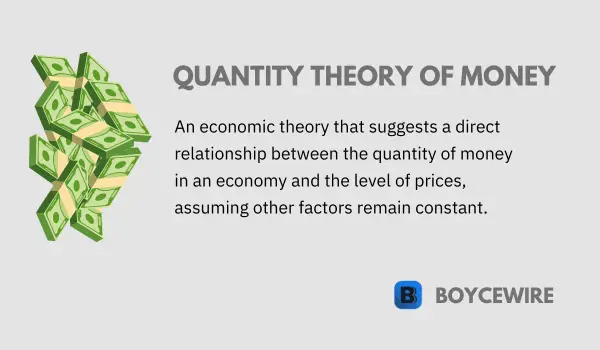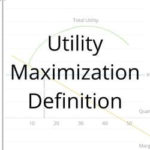Quantity Theory of Money: Definition, Assumptions & Formula

What is the Quantity Theory of Money?
The Quantity Theory of Money is a fundamental principle in economics that presents an intuitive understanding of how money operates within an economy. This theory, which dates back to the 16th century and has been refined by economists such as Irving Fisher and Milton Friedman, asserts that the general price level of goods and services is directly proportional to the amount of money in circulation, or money supply.
The Quantity Theory of Money is often summarized with the equation MV = PQ, where M is the money supply, V is the velocity of money, P is the average price level, and Q is the quantity of output of the economy. While the theory makes certain assumptions and has its limitations, it remains a crucial tool for understanding monetary policy, inflation, and the broader economic climate. This article will delve into the intricacies of the Quantity Theory of Money, its implications, criticisms, and its role in modern monetary policy.
Key Points
- The quantity theory of money suggests that there is a direct relationship between the quantity of money in an economy and the level of prices.
- The theory is based on the equation MV = PQ, where M represents the money supply, V represents the velocity of money, P represents the price level, and Q represents the quantity of goods and services produced.
- According to the quantity theory of money, an increase in the money supply, assuming other factors remain constant, will lead to a proportional increase in the overall price level, resulting in inflation.
Quantity Theory of Money Formula
The Quantity Theory of Money is a monetary theory that explains the relationship between the money supply and the price level in an economy. It is often expressed with the equation MV = PQ. Let’s break down what each of these terms represents:
- M (Money Supply): This term stands for the total amount of money in circulation within a specific economy at a given time. Money, in this context, includes cash, coins, and other forms of money such as demand deposits in banks.
- V (Velocity of Money): This represents the rate at which money is exchanged from one transaction to another. It measures how many times a unit of money (like a dollar) is used to purchase goods and services within a given time period. Velocity is usually calculated as the ratio of nominal GDP to the money supply.
- P (Price Level): This is the average price of goods and services in the economy. It is an aggregate measure, reflecting the current general price level relative to a specific base year.
- Q (Real GDP or Quantity of Output): This term stands for the total quantity of goods and services produced and sold in the economy within a certain period. It represents the real GDP, which is the GDP adjusted for inflation.
To calculate the quantity of money using this formula, you would need to know the values of V, P, and Q. With these values, you can rearrange the equation to solve for M (money supply): M = PQ / V.
It’s important to note that in the real world, both V and Q are not easily controlled or predicted, and they can change for a variety of reasons. Because of this, while the Quantity Theory of Money can be a useful tool for understanding the relationship between the money supply and price levels, it should be used with caution when making practical monetary policy decisions.
Assumptions of the Quantity Theory of Money
The quantity theory of money makes several key assumptions to simplify its understanding of the economy. Here are the primary assumptions made:
- Constant Velocity of Money (V): The theory assumes that the velocity of money is constant, or stable, over time. This means that money circulates at a consistent rate, and changes in the money supply have a direct impact on price levels or output.
- Output at Full Employment (Q): The quantity theory of money also assumes that the economy is always at full employment or its potential output. This means that all resources, including labor, are fully utilized, and the economy cannot produce more goods and services than it currently does. In reality, economies often operate below their full employment levels, leading to less than potential output.
- Money Supply is Exogenous: This means the money supply is determined outside of the economic system, typically by a central bank or other monetary authority. The theory assumes that changes in the money supply do not affect the velocity of money or real output.
- Direct Proportionality: The theory assumes a direct, proportional relationship between the money supply and the price level. That is, if the money supply doubles, the price level will also double, keeping the velocity of money and output constant.
- Neutral Money: In the long run, the theory assumes that money is neutral. This means that changes in the money supply will not affect real variables like employment, real GDP, or the technology level. All changes in the money supply will only result in proportional changes in the price level.
These assumptions, while simplifying the economic model for understanding, are often critiqued as they do not hold in reality. The velocity of money is not constant, economies are not always at full employment, and changes in money supply can have real effects on the economy, especially in the short run.
Implications of the Quantity Theory of Money
The quantity theory of money has several important implications for economic policy and understanding the nature of money in an economy. Here are some of the key takeaways from this theory:
- Inflation is a Monetary Phenomenon: According to the quantity theory of money, inflation is primarily a result of changes in the money supply. If the supply of money grows at a faster rate than the economy’s ability to produce goods and services, it leads to inflation. This understanding underpins many central banks’ strategies to control inflation by regulating the money supply.
- Monetary Neutrality: In the long run, changes in the money supply affect only nominal variables, not real variables such as output or employment. This concept, known as monetary neutrality, implies that while monetary policy can impact price levels, it cannot permanently affect real economic activity.
- Importance of Stable Money Supply Growth: For stable prices, the growth rate of the money supply should be equal to the growth rate of real output. If the money supply grows faster than real output, it can lead to inflation. Conversely, if the money supply grows slower than real output, it can lead to deflation.
- Predictability of Inflation: If the velocity of money is stable and policymakers can control the money supply, the quantity theory suggests that inflation can be predicted and controlled. This has been a cornerstone of many inflation-targeting policies of central banks.
- Limits of Monetary Stimulus: The theory also implies that while increasing the money supply might stimulate economic activity in the short run, in the long run, it will only result in inflation without increasing real output or employment.
It’s important to note that these implications are based on the assumptions of the quantity theory, which are often not applicable in the real world. Therefore, while the quantity theory offers valuable insights, it should be used in conjunction with other economic theories and models to inform policy decisions.
Criticisms and Limitations of the Quantity Theory of Money
While the Quantity Theory of Money has been influential in economics and policy-making, it is not without its criticisms and limitations. Here are some of the main points of contention:
- Velocity of Money Isn’t Constant: One of the core assumptions of the quantity theory is that the velocity of money is constant. However, in reality, the velocity of money can fluctuate due to a variety of factors, such as changes in payment technologies, interest rates, and economic confidence. This can undermine the theory’s ability to accurately predict inflation.
- Oversimplification of Money Supply: The theory simplifies the concept of money supply, treating it as a single, homogeneous quantity that is easily controlled by central banks. In reality, there are multiple components to the money supply (such as cash, checking deposits, and savings deposits), and central banks may struggle to control them all simultaneously.
- Real-world Complications: The theory assumes a closed economy without international trade and capital flows. It also assumes that all money is held domestically and that the economy is always at full employment. These assumptions often do not hold in the real world.
- Ignoring Demand-side Factors: The Quantity Theory of Money focuses on the supply of money but often overlooks demand-side factors that can also influence price levels. For example, a decrease in aggregate demand can lead to deflation, even if the money supply remains unchanged.
- Long-run Focus: The theory emphasizes long-run outcomes, stating that changes in the money supply will not affect real variables like output or employment in the long run. However, in the short run, changes in the money supply can have significant impacts on the economy, which the theory tends to downplay.
Despite these criticisms, the Quantity Theory of Money remains a key component of economic theory, providing valuable insights into the relationship between money supply and price levels. However, most economists agree that it should be used as one tool among many for understanding and managing economies.
FAQs
The quantity theory of money is an economic theory that suggests a direct relationship between the quantity of money in an economy and the level of prices.
According to the quantity theory of money, an increase in the money supply in an economy, assuming other factors remain constant, will lead to a proportional increase in the overall price level, resulting in inflation.
The equation of the quantity theory of money is MV = PQ, where M represents the money supply, V represents the velocity of money (the rate at which money is spent), P represents the price level, and Q represents the quantity of goods and services produced in the economy.
The velocity of money represents how frequently money changes hands in the economy. In the quantity theory of money, assuming a stable velocity of money, an increase in the money supply will lead to an increase in prices.
About Paul
Paul Boyce is an economics editor with over 10 years experience in the industry. Currently working as a consultant within the financial services sector, Paul is the CEO and chief editor of BoyceWire. He has written publications for FEE, the Mises Institute, and many others.

Further Reading
 Utility Maximization: Definition, Example & Limitations - Table of Contents What is Utility Maximization Utility Maximization Rule Utility Maximization Example Limitations of Utility Maximisation Utility Maximization FAQs…
Utility Maximization: Definition, Example & Limitations - Table of Contents What is Utility Maximization Utility Maximization Rule Utility Maximization Example Limitations of Utility Maximisation Utility Maximization FAQs…  Mercantilism: Definition, Characteristics & Examples - Mercantilism is an economic policy whereby a nation aims to maximize exports and minimize the imports.
Mercantilism: Definition, Characteristics & Examples - Mercantilism is an economic policy whereby a nation aims to maximize exports and minimize the imports.  Hindsight Bias: Definition & Examples - Hindsight bias is where an individual claims to have been able to predict an event after it has happened.
Hindsight Bias: Definition & Examples - Hindsight bias is where an individual claims to have been able to predict an event after it has happened. 